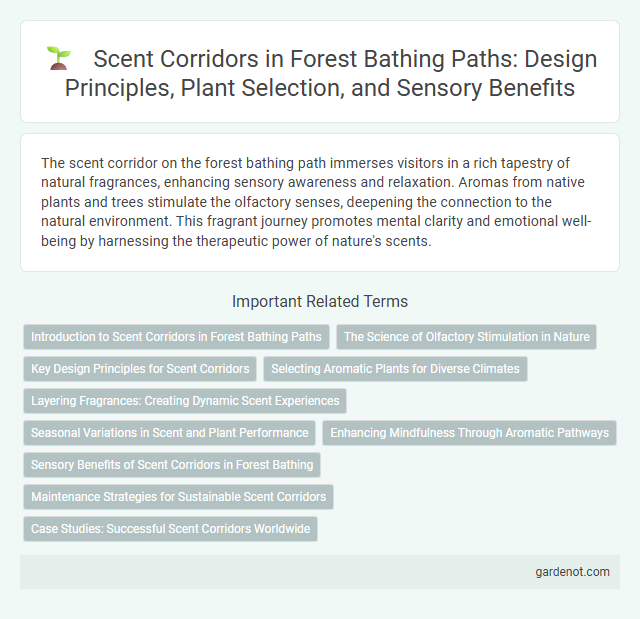The scent corridor on the forest bathing path immerses visitors in a rich tapestry of natural fragrances, enhancing sensory awareness and relaxation. Aromas from native plants and trees stimulate the olfactory senses, deepening the connection to the natural environment. This fragrant journey promotes mental clarity and emotional well-being by harnessing the therapeutic power of nature's scents.
Introduction to Scent Corridors in Forest Bathing Paths
Scent corridors in forest bathing paths are designed to enhance sensory immersion by guiding visitors through areas rich in aromatic plants such as cedar, pine, and eucalyptus. These corridors stimulate the olfactory system, promoting relaxation and stress reduction through natural essential oils released by the vegetation. Strategic placement of fragrant flora within these paths maximizes the therapeutic benefits associated with forest bathing, improving overall mental well-being.
The Science of Olfactory Stimulation in Nature
The scent corridor in a forest bathing path leverages the science of olfactory stimulation to enhance well-being by exposing visitors to a variety of natural aromas such as pine, cedar, and wildflowers. These natural scents activate the limbic system, which regulates emotions and memory, promoting relaxation and stress reduction. Research shows that inhaling phytoncides--volatile organic compounds emitted by trees--boosts immune function and mental clarity, making the olfactory experience essential in forest therapy.
Key Design Principles for Scent Corridors
Scent corridors in forest bathing paths are designed to enhance sensory immersion through strategic plant selection, emphasizing aromatic species with seasonal fragrance variations to engage multiple olfactory receptors. Spatial arrangement prioritizes proximity and layering of scents, enabling gradual intensification and preventing sensory overload while maintaining natural biodiversity. Incorporating microclimate considerations such as humidity and wind patterns ensures optimal scent dispersion and enhances visitor experience along the corridor.
Selecting Aromatic Plants for Diverse Climates
Selecting aromatic plants for a scent corridor in a forest bathing path requires careful consideration of regional climate zones to ensure plant survival and optimal fragrance release. Incorporating native species such as lavender for temperate regions, rosemary for Mediterranean climates, and lemon balm for humid environments maximizes both ecological compatibility and aromatic diversity. This strategic selection enhances sensory engagement by offering a continuous gradient of natural scents that adapt to seasonal variations and environmental conditions.
Layering Fragrances: Creating Dynamic Scent Experiences
Layering fragrances in a forest bathing scent corridor enhances the sensory journey by blending multiple natural aromas such as pine, cedar, and wildflowers to create dynamic scent experiences. This technique mimics the complexity of forest ecosystems, stimulating the olfactory senses and promoting relaxation and mindfulness. Carefully curated fragrance layers evoke emotional responses, deepen immersion in nature, and support mental well-being.
Seasonal Variations in Scent and Plant Performance
The scent corridor in a forest bathing path offers rich seasonal variations, with spring showcasing floral aromas from blooming cherry blossoms and azaleas, while summer highlights fresh pine and cedar scents. Autumn introduces earthy notes from fallen leaves and fermenting fruits, enhancing the sensory experience through complex olfactory layers. Plant performance fluctuates with temperature and humidity, influencing scent intensity and offering visitors dynamic, immersive aromas throughout the year.
Enhancing Mindfulness Through Aromatic Pathways
The scent corridor in a forest bathing path utilizes specific aromatic plants like cedar, pine, and eucalyptus to heighten sensory awareness and promote deep relaxation. Engaging with these natural fragrances helps reduce stress hormones such as cortisol, fostering mindfulness and mental clarity. This immersive olfactory experience supports emotional well-being by grounding individuals in the present moment through the power of scent.
Sensory Benefits of Scent Corridors in Forest Bathing
Scent corridors in forest bathing enhance sensory immersion by activating olfactory receptors with diverse natural aromas like pine, cedar, and eucalyptus, which reduce stress hormones and promote relaxation. These aromatic pathways stimulate the limbic system, improving mood, cognitive function, and emotional well-being. Exposure to phytoncides, the natural volatile compounds emitted by trees, strengthens immune function and supports overall health during sensory-rich forest bathing experiences.
Maintenance Strategies for Sustainable Scent Corridors
Regular pruning and native plant selection are essential maintenance strategies for preserving the ecological balance and aromatic integrity of scent corridors in forest bathing paths. Implementing organic mulching and integrated pest management minimizes chemical usage, ensuring a healthy environment for both plants and visitors. Scheduled soil testing and hydration monitoring optimize plant health, supporting the continuous release of therapeutic scents throughout the seasons.
Case Studies: Successful Scent Corridors Worldwide
Scent corridors like the Shinrin-Yoku trails in Japan demonstrate effective integration of aromatic plants such as hinoki cypress and eucalyptus to enhance mindfulness and stress reduction. The Forest Bathing Path in South Korea employs fragrant herbs like mugwort and lavender, resulting in increased visitor engagement and wellness outcomes. European examples, including the Black Forest Scent Trail in Germany, utilize native conifers and wildflowers to create immersive olfactory experiences that promote mental restoration.
Scent corridor Infographic

 gardenot.com
gardenot.com